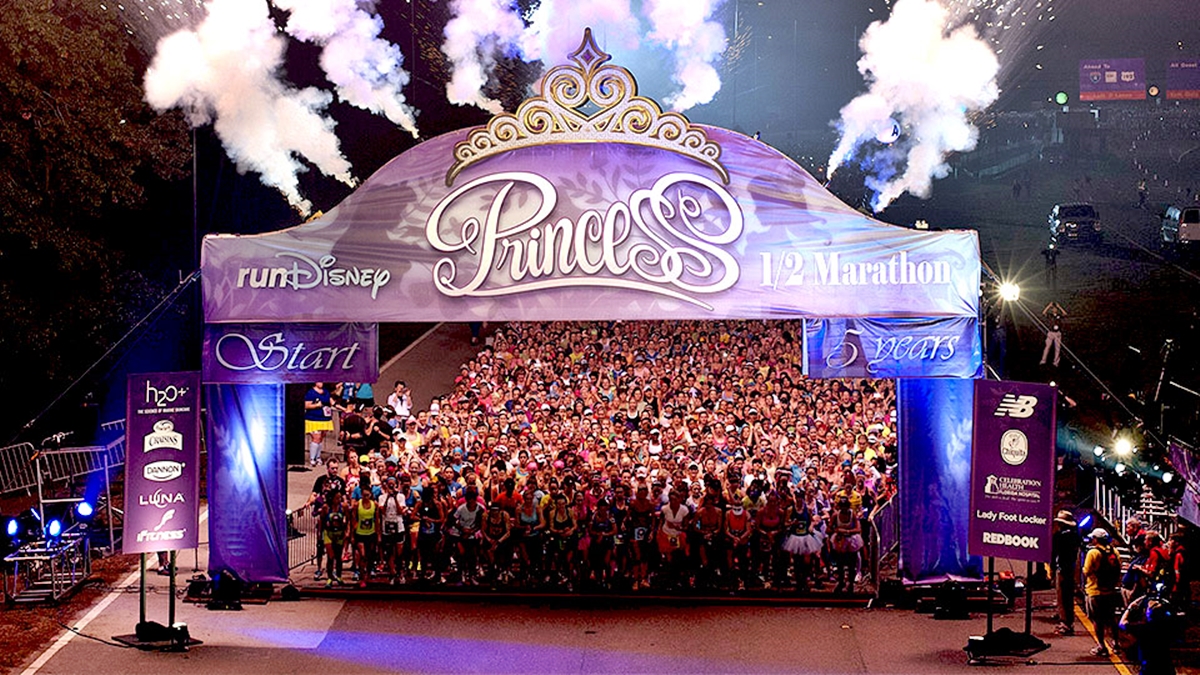Home>Misc>Featured>When To Start Training For A Half Marathon


Featured
When To Start Training For A Half Marathon
Modified: January 22, 2024
Discover when to start training for a half marathon and get featured in the race of your dreams. Gain expert tips and prepare for your best performance.
Introduction
So, you’ve decided to take on the challenge of running a half marathon. Congratulations! This is an exciting endeavor that will test your physical and mental capabilities while pushing you to new limits. However, before you lace up your running shoes and hit the pavement, it’s important to plan and prepare for the journey ahead.
Training for a half marathon requires commitment, discipline, and a well-thought-out strategy. It’s not something you can jump into without proper preparation. In this article, we will guide you through the key factors to consider when starting your half marathon training. From finding the right race to setting a training timeline, evaluating your fitness level to incorporating speed workouts, we’ll cover everything you need to know to make your training a success.
Finding the right race is the first step in your half marathon journey. Consider factors such as location, terrain, and timing when selecting your race. Do you prefer a scenic coastal route or a challenging trail run? Would you thrive in a smaller, local race or prefer the energy of a big city event? Take some time to research and find a race that aligns with your preferences and goals.
Once you’ve chosen your race, it’s important to set a training timeline. Give yourself enough time to gradually build up your mileage and improve your endurance. Most half marathon training plans span 10-14 weeks, but you can adjust according to your fitness level and goals. Remember, it’s better to start early and gradually increase your training rather than cramming it all into a few weeks.
Before diving into the training plan, evaluate your current fitness level. Even if you’re already active, running a half marathon requires a specific level of endurance and strength. Consider factors such as your current running mileage, your pace, and any previous injuries or limitations. This self-assessment will help you tailor your training plan to match your abilities and avoid unnecessary injuries.
Finding the Right Race
Choosing the right race is a crucial step in your half marathon journey. It can greatly impact your overall experience and motivation throughout the training process. Here are some factors to consider when selecting a race that suits your preferences and goals.
Firstly, consider the location of the race. Do you prefer a local race close to home or are you open to traveling to different destinations? Running in a familiar environment can be comforting, but participating in a race in a new city can be an exciting adventure. Consider the logistics of traveling, such as accommodation and transportation, when deciding on the location.
Secondly, think about the terrain and course of the race. Do you prefer a flat and fast course, or are you up for the challenge of hills and varied terrain? Consider how the course aligns with your running strengths and preferences. If you enjoy trail running or scenic routes, look for races that offer those options. On the other hand, if you’re looking to set a personal best time, consider a race with a flat course and favorable weather conditions.
Another important aspect to consider is the size of the race. Are you looking for a big, bustling event with a large number of participants, or do you prefer a smaller, more intimate race? Big races can have a vibrant atmosphere and provide ample support from spectators, but smaller races often offer a more community-focused experience. Reflect on what type of race atmosphere will motivate and inspire you during your training and on race day.
Timing is also a critical factor when choosing a race. Look at your calendar and determine when you’ll have enough time to train effectively. If you have a busy schedule or significant commitments during certain times of the year, consider choosing a race that falls during a period when you can prioritize your training. This will give you the best chance to sufficiently prepare physically and mentally.
Lastly, don’t forget about the race’s reputation and organization. Do some research on the race’s history, read reviews from past participants, and check if it has a good track record in terms of organization, logistics, and participant satisfaction. An efficiently organized race can contribute to a smooth and enjoyable experience for you as a runner.
Setting a Training Timeline
Once you have selected the half marathon you wish to participate in, it’s important to establish a training timeline that will guide your preparation. The length of your training plan will depend on your current fitness level, experience as a runner, and the goals you have set for yourself. Here are some key considerations when setting your training timeline.
Firstly, give yourself enough time to gradually build up your running mileage. Most half marathon training plans range from 10 to 14 weeks, but this can be adjusted based on your individual circumstances. Starting early allows for a gradual increase in mileage, reducing the risk of injury and allowing your body to adapt to the demands of long-distance running.
It’s also important to take into account any other commitments or events that may affect your training schedule. Consider factors such as work, family, vacations, and other activities that may impact the time and energy you can dedicate to your training. By accounting for these in your timeline, you can ensure that you have a realistic and manageable plan.
Next, break down your training timeline into specific phases or milestones. This will help you structure your training plan and monitor your progress along the way. Start with an initial phase focused on building your base mileage. During this phase, the emphasis is on gradually increasing your weekly mileage to improve your endurance and aerobic capacity.
Once you have established a solid base, incorporate speed and tempo workouts into your training plan. These workouts will help improve your speed, stamina, and overall running performance. Intervals, fartlek runs, and tempo runs are examples of workouts that target different aspects of your running fitness.
Long runs are another crucial component of half marathon training. These runs gradually increase in distance to simulate the physical and mental demands of race day. Typically, you’ll aim to complete one long run per week, building up to a distance that exceeds the half marathon distance a few weeks before the race. These runs will help you build endurance and confidence.
In addition to running, cross-training and strength training should also be incorporated into your training plan. Cross-training activities such as swimming, cycling, or strength training sessions help improve overall fitness and reduce the risk of overuse injuries. Include these activities on your non-running days to maintain a well-rounded approach to your training.
Lastly, allow for proper rest and recovery throughout your training timeline. Rest days are just as important as training days as they give your body the opportunity to repair, rebuild, and adapt to the training stress. Schedule regular rest days and easy recovery runs into your training plan to ensure that you are giving your body enough time to recover and avoid burnout.
Evaluating Your Current Fitness Level
Before diving into your half marathon training plan, it’s important to take some time to evaluate your current fitness level. Understanding where you are starting from will help you tailor your training plan to meet your specific needs and goals. Here are some key factors to consider when assessing your fitness level.
Start by looking at your current running mileage. How many miles do you typically run per week? This will give you a baseline understanding of your overall endurance and running frequency. If you are already regularly running around 10-15 miles per week, you may have a solid foundation to begin half marathon training. However, if your mileage is significantly lower, you may need to spend more time building up your base before starting a more intense training program.
Consider your running pace as well. Do you have a consistent running pace, or do you vary depending on the distance and effort? Your running pace is an indicator of your current fitness level and can be used to set realistic goals and training targets. It’s important to be honest with yourself about your pace and avoid comparing yourself to others. Remember, everyone has their own unique starting point and journey.
Take into account any previous running experience or races you have participated in. Have you completed any races before, whether they are shorter distances or other half marathons? These experiences can provide valuable insights into your running abilities and help you gauge how well you handle the demands of longer distance running. Reflect on what worked well in your previous races and what areas you may need to improve upon.
Consider any past injuries or limitations that may impact your training. Running a half marathon puts a significant amount of stress on your muscles, joints, and cardiovascular system. Assess any previous injuries or ongoing conditions that may require special attention or modifications to your training plan. It’s important to listen to your body and seek professional advice if needed to ensure a safe and effective training process.
A self-assessment of your mental readiness is also crucial. Running a half marathon requires mental strength and determination. Evaluate your motivation, commitment, and mindset towards the training process. Are you prepared to invest the time and effort it takes to prepare for a half marathon? A positive and determined mindset will greatly contribute to your overall success.
By taking the time to evaluate your current fitness level, you can tailor your training plan to match your abilities and set realistic goals. Remember that everyone’s starting point is different, and progress is made through consistency and gradual improvement. Be patient with yourself and embrace the journey of preparing for your half marathon.
Building Your Base Mileage
Building your base mileage is a fundamental step in half marathon training. It involves gradually increasing the amount of weekly running mileage to improve your aerobic capacity and endurance. This phase sets the foundation for the more intense aspects of your training program. Here are some key considerations when building your base mileage.
Start by determining your current weekly mileage. This is the total number of miles you are currently running in a week. If you have been consistently running, aim to increase your mileage by 10-15% each week. This gradual increase allows your body to adapt to the growing mileage and reduces the risk of overuse injuries. If your current mileage is low, focus on adding extra running days or slowly increasing the distance on your current running days.
One important aspect of building base mileage is to focus on consistent and easy-paced runs. These runs should be at a comfortable pace where you can maintain a conversation. The goal is to build endurance and improve your aerobic fitness. Avoid the temptation to push too hard during this phase as it can lead to burnout or injuries. Instead, prioritize building a strong aerobic foundation through consistent, easy runs.
Incorporate a variety of run lengths into your weekly schedule. Aim to have at least one longer run each week, gradually increasing the distance. These long runs simulate the demands of the half marathon distance and help build mental and physical endurance. Additionally, include shorter runs during the week to balance your training and provide recovery days.
Consider incorporating cross-training activities into your routine. Activities such as cycling, swimming, or strength training can help improve overall fitness and reduce the risk of overuse injuries. Include cross-training on your non-running days to maintain a balanced approach to your training.
Listen to your body and prioritize rest and recovery. Building base mileage is physically demanding, and it’s crucial to allow time for your body to repair and adapt. Make sure to schedule regular rest days and recovery runs into your training plan. Listen to any signs of fatigue or pain and adjust your training accordingly. Recovery is just as important as the actual training, so don’t overlook this aspect.
Remember, building your base mileage sets the foundation for your half marathon training. Focus on gradually increasing your mileage, maintaining a steady and comfortable pace, and allowing for sufficient rest and recovery. By building a strong base, you will improve your overall endurance, making it easier to tackle the more intense aspects of your training program in the upcoming weeks.
Incorporating Speed and Tempo Workouts
Once you have built a solid base mileage, it’s time to incorporate speed and tempo workouts into your half marathon training plan. These workouts are designed to improve your running efficiency, speed, and stamina. By introducing these challenging workouts, you can take your running to the next level. Here are key factors to consider when incorporating speed and tempo workouts into your training.
Speed workouts involve running at a faster pace than your normal training pace. They help improve your overall speed and anaerobic fitness. One popular type of speed workout is interval training, where you alternate between periods of fast running (at a higher intensity) and periods of recovery. For example, you could do a workout consisting of 400-meter repeats at a faster pace, followed by a short recovery jog. Incorporate speed workouts into your training plan once or twice a week to build speed and power.
Tempo workouts focus on maintaining a comfortably hard pace for an extended period. These workouts improve your lactate threshold, which is the point at which lactic acid starts to accumulate in your muscles. By training at or slightly below your lactate threshold, you can run faster for longer periods without accumulating fatigue. A typical tempo workout involves a sustained effort at a challenging but manageable pace, usually lasting between 20 minutes to an hour. Incorporate tempo runs into your training plan once a week.
When incorporating speed and tempo workouts, it’s important to balance them with your other training runs. These workouts are challenging and place additional stress on your body, so it’s crucial to allow for proper recovery. Avoid doing these workouts on consecutive days and make sure you have a recovery day or an easy run in between. Listen to your body and adjust the intensity and duration of these workouts based on your fitness level and how you’re feeling.
Warm-ups and cool-downs are essential before and after speed and tempo workouts. A proper warm-up consisting of dynamic stretches and a gradual increase in intensity prepares your body for the workout and reduces the risk of injury. Cooling down with some easy jogging and static stretches helps your muscles recover and prevent stiffness. Include at least 5-10 minutes of warm-up and cool-down activities in your speed and tempo workouts.
Remember, speed and tempo workouts are challenging but rewarding. They help improve your running efficiency, speed, and endurance. Incorporate them into your training plan gradually, starting with shorter intervals or less intense tempos and gradually progressing as your fitness improves. Be consistent and patient, and you’ll start to see improvements in your speed and overall performance.
Long Runs and Endurance Training
Long runs are a vital component of half marathon training as they help build the endurance necessary to tackle the race distance. These runs gradually increase in distance to simulate the physical and mental demands of race day. Here’s what you need to know about incorporating long runs and endurance training into your training plan.
The purpose of long runs is to build your aerobic capacity, improve mental stamina, and adapt your body to the demands of running for an extended period. Start with a comfortable distance that you can currently manage and gradually increase it each week. Aim to increase your long run distance by 10% or less each week to allow your body to adapt without overexertion.
When planning your long runs, consider the terrain and conditions similar to your race day. If possible, simulate the race course by incorporating similar elevation changes or surfaces into your long runs. This will help you become familiar with the challenges you may face during the race and build the necessary mental resilience.
Fueling and hydration are essential during long runs to sustain your energy levels. Practice your race day nutrition strategy during your long runs. Experiment with different energy gels, hydration products, and snacks to find what works best for you. Additionally, ensure you hydrate adequately before, during, and after your long runs to prevent dehydration and promote recovery.
Incorporate goal or race pace segments into your long runs to practice maintaining your target pace when fatigued. This will help build mental and physical toughness, and familiarize you with the feeling of running at your desired pace during the race. Start with shorter segments and gradually increase their length as your endurance improves.
Consider running with a training partner or joining a running group for your long runs. Having someone to share the miles with can provide motivation, accountability, and make the experience more enjoyable. It’s a great opportunity to connect with fellow runners and draw inspiration from each other.
Remember to prioritize rest and recovery after your long runs. Allow your body time to heal and rebuild by incorporating rest days or easy runs into your training plan. Take care of any sore or tight muscles through stretching, foam rolling, and other recovery techniques. Proper recovery is crucial for preventing injuries and ensuring you bounce back stronger for your next training session.
Endurance training is not limited to just long runs. It’s important to focus on maintaining a consistent training schedule and gradually increasing your overall weekly mileage. This allows your body to adapt and improve its endurance capacity. Incorporate shorter runs during the week to complement your long runs and provide a well-rounded training plan.
By incorporating long runs and endurance training into your half marathon training plan, you will build the necessary stamina to conquer the race distance and develop mental resilience. Remember to be patient, stay consistent, and listen to your body throughout the process. Embrace the challenge and enjoy the journey towards achieving your half marathon goal.
Cross-training and Strength Training
Cross-training and strength training are essential components of half marathon training that complement your running workouts. Incorporating these activities into your training regimen can enhance your overall performance, reduce the risk of injury, and improve your running economy. Here’s what you need to know about cross-training and strength training during your half marathon preparation.
Cross-training involves participating in activities other than running to supplement your cardiovascular fitness and build strength in different muscle groups. Popular cross-training activities include swimming, cycling, elliptical training, and rowing. Engaging in cross-training activities on your non-running days provides a break from the repetitive impact of running while still maintaining your cardiovascular fitness.
Cross-training helps to improve your aerobic capacity, build endurance, and prevent overuse injuries. By engaging in different activities, you challenge your body in new ways and work different muscle groups. It can also provide a mental break from running, keeping your motivation high throughout your training program.
Strength training is another important component of half marathon training. It involves exercises that target specific muscle groups, helping to improve strength, stability, and overall running performance. Focus on exercises that strengthen your lower body, core, and upper body to maintain a balanced and strong physique.
Incorporate exercises such as squats, lunges, deadlifts, and calf raises to target your lower body muscles. For core strength, include planks, Russian twists, and standing side bends. Don’t neglect your upper body either, as a strong upper body helps maintain proper running form and posture. Push-ups, pull-ups, and shoulder presses are beneficial exercises to include in your routine.
When it comes to cross-training and strength training, consistency is key. Aim for at least two to three cross-training sessions and two strength training sessions per week. Incorporate these activities on your easy or rest days to provide active recovery for your running muscles.
Remember to listen to your body and avoid overtraining. If you feel excessively fatigued or experience any pain or discomfort, adjust your training intensity or seek professional advice. Proper form and technique are essential during strength training to prevent injuries, so consult a trainer or do thorough research to ensure you are executing the exercises correctly.
Additionally, don’t forget to prioritize rest and recovery between your running, cross-training, and strength training sessions. Allow your body time to adapt and repair by incorporating rest days into your training plan. Proper sleep, nutrition, and hydration are also crucial for optimal recovery and performance.
By incorporating cross-training and strength training into your half marathon training plan, you’ll improve your overall fitness, enhance your running performance, and reduce the risk of injuries. Embrace the opportunity to diversify your workouts, challenge your body in new ways, and become a stronger and more well-rounded runner.
Proper Rest and Recovery
Rest and recovery play a crucial role in half marathon training. It’s during periods of rest that your body repairs and adapts, leading to improved performance. Neglecting rest and recovery can increase the risk of injury, hinder progress, and negatively impact your overall well-being. Here’s what you need to know about incorporating proper rest and recovery into your training plan.
Firstly, prioritize regular rest days throughout your training program. These are designated days where you allow your body to fully recover and rejuvenate. Rest days help prevent overuse injuries, reduce muscle fatigue, and replenish energy stores. Embrace rest days as an integral part of your training rather than viewing them as ‘skip days’.
On rest days, engage in activities that promote relaxation and rejuvenation. Activities such as walking, yoga, stretching, or foam rolling can help improve flexibility, decrease muscle soreness, and aid in recovery. These low-impact activities allow for active recovery while putting minimal stress on your body.
Proper sleep is vital for recovery. Aim for 7-9 hours of quality sleep each night to allow your body to repair, rebuild, and recharge. Sleep deprivation can negatively affect your immune function, energy levels, and overall recovery process. Establish a consistent sleep routine and create a sleep-friendly environment to optimize your rest.
Nutrition also plays a critical role in rest and recovery. After intense workouts, prioritize consuming a balanced meal or snack within the first 30-60 minutes. This window is when your body is most receptive to replenishing glycogen stores and facilitating muscle repair. Include a combination of carbohydrates for energy replenishment and protein for muscle recovery in your post-workout nutrition.
Hydration is essential for proper recovery. Throughout the day, aim to drink adequate fluids to stay hydrated. During intense workouts or long runs, consider consuming electrolyte-rich drinks to replenish lost electrolytes and aid in hydration. Listen to your body’s thirst cues and ensure your urine is pale yellow to clear, indicating proper hydration levels.
Cross-training, as mentioned earlier, can serve as active recovery between your running workouts. Engaging in low-impact activities such as swimming, cycling, or yoga on your rest days can promote blood circulation, enhance flexibility, and aid in muscle recovery. These activities offer a break from the repetitive stress of running while still maintaining your fitness level.
Pay attention to any signs of overtraining or burnout, such as persistent fatigue, decreased performance, irritability, or increased susceptibility to illness. If you experience these symptoms, adjust your training intensity or volume to allow for proper recovery. It’s better to take an extra day or two of rest rather than pushing through and risking injury or prolonged fatigue.
Remember, rest and recovery are just as important as the training itself. Embrace rest days, prioritize quality sleep, nourish your body with proper nutrition, and stay hydrated. By giving your body the time and space it needs to recover, you’ll optimize your training, reduce the risk of injury, and perform at your best on race day.
Tapering before the Race
Tapering is a crucial part of your half marathon training that involves reducing your training volume and intensity in the final weeks leading up to the race. This period of rest and recovery allows your body to fully recharge, repair, and prepare for peak performance on race day. Here’s what you need to know about tapering before the race.
The tapering period typically lasts around two to three weeks, but the exact duration can vary depending on your training plan and individual needs. The general principle is to gradually decrease your training load while maintaining some level of activity to prevent detraining.
Tapering allows your body to recover from the accumulated fatigue of your training while maintaining the fitness gains you’ve made. It gives your muscles the opportunity to repair and rebuild, ensuring that you start the race feeling fresh and well-rested.
During the taper, reduce your weekly mileage by around 20-30% compared to your peak training weeks. However, this reduction does not mean you should completely stop running. Instead, maintain some level of activity to keep your muscles engaged and maintain your cardiovascular fitness.
Maintain the intensity of your workouts during the taper but reduce the volume. Shorter, faster-paced runs can help maintain your speed and race pace without excessively fatiguing your body. Aim for shorter interval sessions or tempo runs rather than long, grueling workouts.
Focus on incorporating more rest and recovery activities during the taper period. Include additional rest days in your training plan and use this time to prioritize sleep, proper nutrition, and hydration. Allow yourself to fully recover and rejuvenate both physically and mentally.
It’s essential to listen to your body during the taper period. If you feel any lingering fatigue or niggling injuries, take extra rest or modify your training accordingly. It’s better to be slightly undertrained and injury-free than to risk overtraining or exacerbating any existing issues.
Tapering can sometimes lead to feelings of restlessness or anxiety as you reduce your training volume. It’s important to trust in your training and have confidence in the work you’ve put in. Use this time to focus on mental preparation, visualization techniques, and positive self-talk to build your race day mindset.
Keep in mind that everyone’s tapering needs may vary, so it’s essential to experiment and find what works best for you. Pay attention to how your body responds to the tapering period and make any necessary adjustments along the way.
Ultimately, the taper period is about finding the right balance between rest and maintenance of fitness. Embrace this period as a time to recharge and prepare mentally and physically for the race. Trust in your training, take care of your body, and arrive at the starting line feeling ready to give your best effort.
Conclusion
Training for a half marathon is a challenging and rewarding endeavor that requires dedication, discipline, and careful planning. By following a well-structured training plan, you can gradually build your endurance, improve your speed, and prepare yourself for the race day. Throughout the training process, it’s important to prioritize key elements such as finding the right race, setting a realistic training timeline, evaluating your current fitness level, building base mileage, incorporating speed and tempo workouts, completing long runs for endurance, cross-training and strength training, allowing for proper rest and recovery, and tapering before the race.
Finding the right race that matches your preferences and goals sets the stage for an enjoyable race day experience. Setting a training timeline gives structure to your training program and allows for gradual progression. Evaluating your current fitness level helps tailor your training plan to match your abilities and avoid injuries. Building base mileage establishes a solid foundation for your training, while incorporating speed and tempo workouts improves your overall speed and stamina.
Long runs and endurance training simulate the demands of race day, and cross-training and strength training complement your running workouts by improving overall fitness and reducing the risk of overuse injuries. Proper rest and recovery are essential for allowing your body to repair and adapt, while tapering before the race ensures that you arrive at the starting line feeling fresh and prepared.
Remember, training for a half marathon is a journey that requires patience, commitment, and persistence. Listen to your body, make adjustments as needed, and stay consistent with your training. With proper preparation and a positive mindset, you can cross the finish line of your half marathon with a sense of pride and accomplishment. Good luck and enjoy the incredible experience of training for and completing your half marathon!









